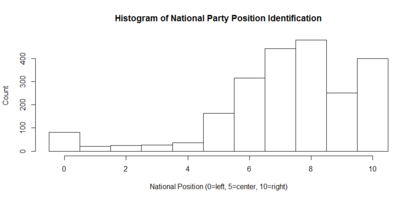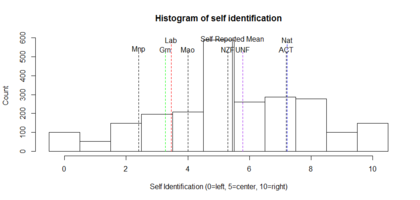Polity: Meet the middle
254 Responses
First ←Older Page 1 2 3 4 5 … 11 Newer→ Last
-
giovanni tiso, in reply to
You notice how disaffected National factions DIDN'T do that with Don Brash?
No although they did leak his emails.
-
Rob Salmond, in reply to
…then you have to conclude that actually a lot more people are right wing than left wing…right off the bat. Because that’s what they said they were.
Not quite, because that same sample rate Labour closer to the ideological median than National. Labour average rating is 3.46, National is 7.22. Same pattern holds for people who self-identify as a 5.
In any case, as I mentioned before, I expect the patterns of media use, political views, etc will be pretty much the same for "ideology=5" and "ideology between Labour and National," meaning we're really talking about a distinction without a difference.
-
giovanni tiso, in reply to
I recall one poll while Labour in government which had a surprisingly high number of self-professed Green voters taking a pretty harsh stance on beneficiaries – more than Labour voters, from memory.
I think it was this one from near the end of National's first term.
-
chris, in reply to
While centrists often do not have strongly held ideological views, they do have beliefs and values. They don’t wake up each morning waiting for ideologues to fill their empty heads with things to think.
But aren’t you an idealogue here to fill empty heads with things to think? Who’s watching the news these days? Are beliefs and values immutable? Aren’t Duncan Garner, Mike Hosking et al in part employed for their persuasiveness? Do their opinions inform peoples’ values and beliefs? Do their opinions inform peoples’ thinking? Wasn’t Labour’s 2014 shellacking in part attributable to its failure to harness a runaway media that was encouraging people to think along certain lines? Did Labour capture thought streams in order to redirect them to a less hostile narrative? How was the framing effect capitalised on by the victors?
Two campaigning advocates of centrism, one who is on the pulse and therefore attuned to just how open the middle’s minds are and the attractiveness of persuasive rhetoric, the other who attempts to minimise the open mindedness of the middle and to campaign along the lines of the road already traveled by others .
Labour needs proper social democratic policy in order to stay Labour. Instead it’s about – for want of a better word – “narrative.” And issue emphasis.
Labour needs a salesperson.
if Labour had convinced the population that the most important problem facing New Zealand was lack of public investment, the left could have won.
If Labour had convinced the general population of anything they might have come close. Largely irrelevant speculation. Capture imagination - possibly requires some.
-
It seems odd that there isn't a swingeing centrist party at one third of the actual vote. Not your bigot party like NZ first or quasi Christian conservatives but a Party with no policy, no ideology just sharp clothes and $100 haircuts.
A guaranteed coalition partner with any party and a refuge for expired celebrities and knackered sports stars. The stuffing in the turkey. -
Rob Salmond, in reply to
It seems odd that there isn’t a swingeing centrist party at one third of the actual vote.
See "Median Voter Theorem" for the reasons why.
-
BenWilson, in reply to
Not quite, because that same sample rate Labour closer to the ideological median than National. Labour average rating is 3.46, National is 7.22. Same pattern holds for people who self-identify as a 5.
OK, but the median is 5, because this is an integer value and that's by far the biggest group...the mean is 5.44. If you're using means for the others, you should compare to a mean. And National is closer to that than Labour.
-
Sacha, in reply to
the chance they go the other way
yep, there's the unpredictable factor.
-
I'm not sure how
learning more about every voter before we make contact
is going to play out in NZ.
The US is both legally and culturally a less private environment than NZ. There's no effective data protection law, for instance, and a the primary system means a large number of voters are registered supporters of a party.
In NZ, all a party has to go on to start with is name, address and age from the electoral roll - I'm not sure what can be learnt from that. All other data is limited by privacy legislation which requires the person to have given consent - do the terms of use of Airpoints or Baycorp data extend to allowing political parties to buy and use that data?
And I'm not convinced that cold calling people with a file on them in front of your rep is going to go down well. You might be better pretending to be the other lot whilst doing that.
-
Sacha, in reply to
Can you overlay those party positions as points on your histogram, if you get time?
-
Aside from the "median voter theory." This may be why there isn't a centre party
http://news.stanford.edu/news/2015/may/political-centrist-voters-051515.html
-
Why pitch your votes to the status quo. Surely good leaders have a vision and go about persuading voters to that cause. I know that whatever logic you use it will never get through to many people but surely there are enough thinking intelligent people around for whom a good message will work.
Peter Malcolm Income Equality Aotearoa NZ Inc "Closing the Gap" -
It's not some immutable law of nature that the centre is "rightish" and we need to obfuscate leftist policies in order to get the centrists to swallow them. The centre could just as easily be leftish if we didn't have a) a high proportion of third way numpties in Labour and b) a well-oiled Nats-friendly propaganda machine in high gear.
-
BenWilson, in reply to
-
I guess the only real turn up in that graph is that the sample rated ACT and National as about as right wing as each other. It's a little hard to see, because I used yellow for ACT, but it's also nearly overlaid by National's line.
Arse, I notice the x scale got fucked up...will redo
-
chris, in reply to
It’s pretty odd to see the Maori party visualised that far right of Labour given respective positions on recent real world issues such as the Foreign fighters bill.
-
-
This is silly. Why be so utterly preoccupied with this left/right malarky when it has no relevance whatsoever for most people. I'd even argue it's of no relevance to most people in this discussion.
Folks votes is driven by tons of stuff: sex appeal, parties' stated intentions, how their parents voted and - lest we forget - what's in it for them: how much break they get promised. "Policy" is boring. "Intentions" are better, especially when they look like tax breaks.
If a party clusters its policies in a certain way, all that really tells you is that it's ideologically consistent. But ideological consistency is probably the least influential vote driver. So, when National legalises gay marriage, it's inconsistent but agile. When Labour flogs off state assets, it's inconsistent but treacherous.
-
Why doesn't the italic code ever work for me?
Anyway, Rob, on the thing about
Lab+Greens
If Green is to the left of Labour, and swingers have to be centrists, how come National voters can defect to Green without going through Labour?
-
BenWilson, in reply to


If you’re using means for the others, you should compare to a mean.
That said, if you compare medians instead, the median self reporting is 5, but for Labour it’s 3 and National it’s 8. So the median opinion on Labour’s position is that it’s closer to the self-reported median than National. And National is more skewed on this measure. Labour’s mean is higher than it’s median by 0.46. National’s mean is lower than its median by 0.78.
Ironically, in statistics terminology this means that the Labour data is right skewed and the National data is left skewed. Well, probably. Looking at these two graphs it looks like it.
-
Sacha, in reply to
Why doesn't the italic code ever work for me?
use two underlines on each end, not one
-
Argh! Travelling for work so I can't argue through the medium of graphs (thanks for the plots Ben).
But I do want to take issue with the opening statement around 1/3 left 1/3 right and the middle deciding the election. That is absolutely only the case if the voting population, which is not the same as the electoral roll population, vote in similar proportions to the electoral roll population. In a time of 76% turnout, heavily biased by age, it is fundamentally the people that vote that decide the election, and the winning block margin is something like 38.1% of the total roll voters.
-
Sacha, in reply to
Thank you. Yes, the ACT/Nat matchup is interesting. If voters can see that, it makes me ponder their support for some govt initiatives.
And I see Maori Party, NZ First, and United Future inhabit the 'space' between Lab and Nat.
-
I don't know if there's much reliable grounds for thinking that non-voters differ ideologically that much from voters though --- certainly in NZ left-wing parties can win on low turnouts and high turnouts, and ditto right wing parties.
-
BenWilson, in reply to
And I see Maori Party, NZ First, and United Future inhabit the ‘space’ between Lab and Nat.
At least in this particular dimension. Auckland is between Sydney and Melbourne, if you take only latitude into account.




Post your response…
This topic is closed.